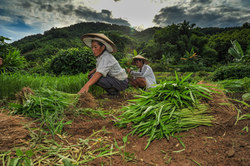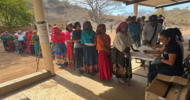
Front. Sustain. Food Syst. | 27 June 2022
The impact of unimplemented large-scale land development deals
Rikke Brandt Broegaard1*, Thoumthone Vongvisouk1,2 and Ole Mertz1
1Department of Geoscience and Natural Resource Management, University of Copenhagen, Copenhagen, Denmark
2Department of Watershed Management and Land Use Planning, Faculty of Forestry Science, National University of Laos, Vientiane, Laos
Although many land deals are never implemented to production stage, little is known about how abandoned projects affect local communities and the government agencies that promote them. This article analyses the effects on local actors, their land access, land use and tenure security of a large-scale bio-fuel land deal in northern Laos that a Chinese company initiated but subsequently abandoned before reaching the planting and production stage. The project left local people bound by contracts without cancellation clauses and with livelihood losses, until the investment contract eventually was annulled by Lao state actors. The deal has prepared the provincial government to receive new investors to further the modernization of agriculture and a land-based economic growth, both in terms of identifying land for development, and experiences gained of how to handle international investors. However, it seems unlikely that local actors can decline future projects when interests of investors and government actors overlap–interests that may not be limited to those officially stated as the objectives of the land deal. A more accurate terminology and additional research is needed to shed light on the outcomes of land deals that for some reason never reach a production stage, whether as a “virtual,” or “failed” land deal.
Introduction
It is well-known that many land deals fail to materialize into actual investments in productive activities (Schoneveld et al., 2011; Cotula, 2013; Nolte et al., 2016; Sipangule, 2017; Nolte, 2020) and/or never deliver the associated expected benefits to governments and employees. However, despite the increasing interest in large-scale land acquisitions in developing countries (Deininger and Byerlee, 2011; Cotula, 2012; Oberlack et al., 2016; Lay and Nolte, 2018), there has been limited research on the effects of unimplemented land deals, understood as those never reaching the production stage. Many studies recognize the issue of abandoned or under-implemented deals in which production may have been initiated at some level (McCarthy et al., 2012; Holden and Pagel, 2013; World Bank UNCTAD, 2014; Agrawal et al., 2019), but the impacts of unimplemented or failed deals have received limited attention except for a few very recent studies (Nolte, 2020; Chung and Gagné, 2021).
It might seem counterintuitive that large land deals should remain unimplemented, especially because they are often portrayed positively by a range of actors as putting “empty,” “idle” or “underused” land to better use (Deininger and Byerlee, 2011; Li, 2011; Lavers, 2012b; Moreda, 2015), by contributing with technological improvements and productivity gains through intensification (World Bank UNCTAD, 2014), infrastructure development (Kugelman, 2009; Lavers, 2012a,b; Schoneveld and Zoomers, 2015), and job creation in rural areas (Li, 2011; Schoneveld et al., 2011; Brautigam, 2015; Lay and Nolte, 2018). However, McCarthy et al. (2012) point out that some investors go into land deals without intending to use the land for the purpose mentioned in permits or project descriptions, and found that partially implemented land acquisitions tend to be a “façade” that cover an agenda of appropriating subsidies or obtaining bank loans based on land permits as collateral (p. 523). They term these situations “virtual land grabbing”, thereby indicating that the land deal may be a vehicle to something other than land control and agricultural production. As an example, Brautigam (2015) describes an ambitious biofuel project in Zambia between 2009 and 2013, where the same Chinese company that is presented in this article pulled out after having aroused much enthusiasm and high-level political support from government (and critique from the political opposition). The departure appeared to have been caused either by domestic political changes in China preventing them from starting at very large scale or because the production was never intended from the outset and thus a “virtual” land grab (see also Schoneveld et al., 2014).
From the perspective of state actors, large-scale land investment projects may also be used primarily for the extension of state domination over frontier areas and/or ethnic minorities (Lavers, 2012a,b, 2016; Baird, 2014; Suhardiman and Giordano, 2014; Moreda, 2015; Moreda and Spoor, 2015). This has been clear since research attention shifted from looking mainly at the international actors in large scale land deals to also focus on the national and local elites (Peluso and Lund, 2011; Lavers, 2012a; Baird, 2014; Bachriadi and Suryana, 2016), because land deals with foreign investors may also be used to promote national political agendas or personal interests (Barney and Van der Meer Simo, 2019; Chung and Gagné, 2021).1
Land deal data and literature often distinguish between the implementation phases (preparation, production, closure) of the land-based investment projects (see for example the Land Matrix). Recent literature on land deal failures defines “failed projects” as those land-based investment projects that do not lead to operational farms (Nolte, 2020) or operations that cease project operation, abandon the land, use less than half the land granted, or do not show higher yields than smallholders (Schönweger and Messerli, 2015). Although they are certainly failed in relation to the stated intentions of higher or more valuable production, it may be relevant to reflect on whether the abandonment or lack of implementation might still be an intended outcome by some actors, or an outcome that can be turned into a benefit for some, while at the detriment of others, thereby reflecting existing unequal power relations (Chung and Gagné, 2021).
While it is logical that failed or unimplemented projects are unlikely to have achieved any of the key expected positive effects like employment creation (Nolte, 2020), it is important to acknowledge that they can have many adverse impacts in the area where they are located. This includes local communities' loss of land access, and negative impacts on soil, water, and biodiversity. While the abandonment of investment projects that were never welcomed by the local population in the first place may be received with some kind of relief for affected communities, the literature shows that it would be naïve to expect things to revert to the situation prior to the investment project. Land-based investments often lack exit strategies (Wåhlin, 2017), and abandonment of projects is unlikely to restore the past status quo as they have often already provoked path-dependent changes (Li, 2017).
The consequences of the failed or unimplemented land deals for local communities are an understudied aspect of large-scale land investments. We argue that an unpacking of the implemented/unimplemented dichotomy by looking at what is at stake for investors, government actors and for local community members can help alert attention to the impacts of “virtual” land grabs, or projects that get abandoned before the production phase. In order to achieve this, we use a longitudinal case-study from northern Laos to analyse whether there are tangible effects of a large-scale land deal that never reached its production stage before it was abandoned by the investor.
Before addressing the case, we start by introducing the theme of land deals and land investment projects with an emphasis on the nuances distinguishing abandoned, failed or “unimplemented” projects, and the need for a better understanding the reasons why some projects stay “unimplemented”, as well as their consequences. We briefly introduce Laos as a relevant setting for studying local development implications of land deals, including the abandoned ones, then we present the study area and the methodology of the study. The remainder of the paper presents what turned out to resemble a virtual land deal, from arrival, excitement, resistance and despair to abandonment and only partial relief. It analyses the local implications and the lasting changes for example as power-struggles intensified during the negotiation between local land rights vis-à-vis the investment project.
Land Deals and Land Development: Abandonment, Failure, or Lack of Implementation
Despite ambitious goals presented by most land investors in the project preparation phase, creating high expectations for host-country benefits, land deals often deviate from the original plans and contracts (Deininger, 2011; Arezki et al., 2013). A study by Boche and Anseeuw (2013) concluded from a southern African context that even among projects that get as far as obtaining formal land rights, many fail prior to reaching the production phase. Schönweger and Messerli (2015) call for more research into why land deals fail, get abandoned or remain unimplemented. “Failures” may be due to unsuccessful activities (Cotula et al., 2014), whether relating to firm internal changes, market-changes or political risks (Nolte, 2020). Globally, large projects, biofuel-projects and projects targeting land that was formerly used by local small-scale farmers or pastoralists have the highest likelihood of failing (Nolte, 2020). Other reasons for low implementation rates include changing investment conditions, unrealistic project design, different technical obstacles, and infrastructural constraints (Deininger and Byerlee, 2011). Furthermore, in a pan-African review of experiences with commercial agriculture, Poulton et al. (2008) highlight the often higher-than-expected costs related to land, negotiations and securing of land investments that follow from local discontent with land allocations to commercial agricultural enterprises. These costs could be related to dealing with local resistance toward the investment projects (Smalley and Corbera, 2012; McAllister, 2015). Deviations from project plans and contracts may also indicate that investors' intended use was different from what was presented in their investment plans (McCarthy et al., 2012; Smalley and Corbera, 2012; Arezki et al., 2013; Schönweger and Messerli, 2015; Chung and Gagné, 2021).
According to several studies, “satisfactory” local benefits depend on projects being profitable and well-managed (Poulton et al., 2008; Deininger and Byerlee, 2011; World Bank UNCTAD, 2014). Thus, unprofitable and non-operational projects are less likely to provide local benefits (ibid.), and failed or unimplemented projects are unlikely to have achieved any of the key expected positive effects like employment creation (Nolte, 2020).
However, since unimplemented deals never really enter the project management phase, there are methodological challenges related to studying impacts of such deals, especially when there is a lack of longitudinal data. Based on global datasets a decade back, Deininger and Byerlee (2011) found that farming had only started on roughly 1/5 of the announced land deals. Similarly, Cotula et al. (2014) found that most land deals in Ethiopia, Ghana and Tanzania had implemented activities on less than a third of the allocated land, while Johansson et al. (2016) found implementation rates as low as 3 per cent for the contracted land deals in Africa (see also Agrawal et al., 2019). The implementation rate seems to have increased over the years, based on more recent data sets (Nolte et al., 2016), probably because having large “tracts of land occupied without utilization” may be detrimental to governments' goals of increasing agricultural productivity (Arezki et al., 2013, p. 203). Local costs related to unimplemented projects, in terms of lost access to land and other natural resources, and/or displaced employment or investments, are acknowledged in several studies (Deininger and Byerlee, 2011; Li, 2011; World Bank UNCTAD, 2014; Agrawal et al., 2019). All these areas are affected by “land deals in limbo” (Chung and Gagné, 2021, p.596), making it relevant to explore the concepts of both implementation and failure and their consequences.
A failed project is one that does not lead to an operational farm through putting the acquired land rights into productive use (see for example Schönweger and Messerli, 2015; Nolte, 2020), and/or one that was never implemented. As outlined above, there is much anecdotal evidence that some “failed” land deals may be the result of speculation, but it could also be that agricultural investors are more willing to accept high risks than investors in other sectors (Lay and Nolte, 2018; Nolte, 2020). However, some of these deals may indeed be so-called “virtual” land deals where the land control is only a means to access something else (McCarthy et al., 2012), and where agricultural production is not the primary motivation (Arezki et al., 2013). For example, an investment contract may be signed, for a foreign investor to return to its host country and use the investment contract as collateral for favorable loans, or as a way to obtain subsidies, or speculate on future land price developments (McCarthy et al., 2012). In the cases of “virtual” land deals, the investor is likely to obtain the underlying, driving objective, even though the stated productive purpose is never implemented. In such cases, conceptualizing the “abandonment” or lack of implementation as a “failure,” masks that implementation was maybe never the actual purpose of the prospective investor.
When studying the socioeconomic impacts of land deals, one must distinguish between different phases of land investments (Schoneveld et al., 2011; Cotula et al., 2014; World Bank UNCTAD, 2014), as well as between the different actors' role in the investment project. This is also highly relevant in the case of abandoned or partially implemented deals. For example, for government officials, potential benefits and costs are different, and may be differently distributed in time, as some invest into establishing good relationships (Chung and Gagné, 2021) and doing feasibility studies that are likely to generate benefits in the pre-investment phase, such as “finders fees” offered to participating officials (Barney and Van der Meer Simo, 2019). Infrastructure development, tax base increase and economic activity will accrue only as production is prepared. For the investors, however, the costs are likely to dominate in the beginning of the land-based investment (during identification and preparation of the investment project), but this of course becomes irrelevant in case of virtual land deals where the investment never materializes. Seen from the point of view of a local farmer, the loss of land access is likely to start when the investment contract begins, whereas market provision or employment generation may only accrue over time, and it may or may not be attractive from a livelihood, socio-cultural or economic point of view (Barney and Van der Meer Simo, 2019; Nolte, 2020). If the deal is not implemented, the lack of benefits is only more certain, and losses may still have occurred.
The concept of loss is contested and hinge on whether land by different actors is considered as idle or productive, natural or degraded, unclaimed or occupied, or within or outside of expected yield levels (Sowerwine, 2004; Hall et al., 2011; Li, 2011, 2014; Lu and Schönweger, 2017; Rigg, 2020). Much land used by smallholders under low intensity cropping or pasture is classified as available and suitable for investment, as its current use is deemed to fall short of its economic potential (Lu and Schönweger, 2017). It thus becomes a political act to include or exclude who can use or access the land, under which conditions, as well as to define the states' claim to that land as territory (Vandergeest and Peluso, 1995; Lu and Schönweger, 2017). In many post-socialist or post-colonial states, land ultimately belongs to the state, which makes the tenure rights and land access for local land users an issue of constant negotiation with different actors within the state, or foreign investors (Rigg, 2012, 2020; Lu and Schönweger, 2017), the latter often invited by state actors interested in increasing foreign direct investments, access to technology, employment or a “modernized” farming sector (ibid.).2 And when certain land uses in addition are considered of low productive and environmental value, then both the state and foreign investors could consider failed land development efforts to be acceptable as long as they generate the non-productive results such as collateral and increased land control mentioned previously.
The political character of local or national systems of land categorization and regulation, which forward state territorialisation processes, may be largely un-noticed by foreign investors, although interests in promoting land-based investments may coincide between investors (whether being private sector or state actors) and host state actors. Despite of international agendas aiming to protect land and water rights of smallholders and local populations,3 the tools themselves or the implementation of them may fall short of protecting the interests of local people, ethnic minorities, women, or other marginalized groups (Fontana and Grugel, 2016; Zoomers and Otsuki, 2017). Without a certain degree of balance in negotiating power between the parties of an agreement, outgrower schemes will fail to benefit the involved farmers (Lavers, 2012b). This requires that outgrower-farmers must “have the capacity to decline an agreement if it is not in their interests” (Lavers, 2012b, p. 814). Unfortunately, this will often necessitate the active involvement of the state to ensure negotiation support to the local farmers (Li, 2011), something that the vast land-grab literature has shown is often not the case (Baird, 2011, 2014; Lund, 2011; Schoneveld et al., 2011; Borras and Franco, 2012; Borras et al., 2012; Cotula, 2012; Hall et al., 2015; Moreda, 2015; Chung and Gagné,2021).
Land Developments in Laos
Laos provides a relevant setting for studying local development implications of land deals, including the partially implemented or abandoned ones, as land deals are plentiful. The Government of Laos uses its rich natural resources as a growth engine, especially to attract foreign investments (Dwyer, 2007, 2014), presenting Laos as a sparsely populated, land abundant country, with plenty of “underutilized” or “degraded” land (Barney, 2009; Lestrelin et al., 2012). However, the “abundant land” is being placed under stricter control by still incomplete land reforms and land use planning efforts aimed at regulating the use of land and natural resources through mapping and zoning exercises (Lestrelin et al., 2012). These reforms extend the influence of the state into rural communities, often resulting in dispossession or restrictions in traditional use of natural resources (Lund, 2011; Castella et al., 2013; Ducourtieux, 2013; Broegaard et al., 2017; Lu and Schönweger, 2017), and foreign land investors may–from the point of view of state actors–help in this process to extend control over areas, where the state control is still weak or contested.
In Laos, there are multiple competing state institutions involved in land granting activities (Lu and Schönweger, 2017), and despite having a centralized political system, policies are reinterpreted during their implementation at provincial and municipal levels to fit local realities or interests of local actors (Broegaard et al., 2017; Lu and Schönweger, 2017). As a state characterized by fragmented sovereignty (Lund, 2011), different state institutions at different administrative levels may contradict each other in their competition for power (Schönweger et al., 2012; Lu and Schönweger, 2017). Plans at different administrative levels may be ignored or overruled when money is to be made (Dwyer, 2014; Baird and Fox, 2015; Broegaard et al., 2017).
There was a 50-fold increase in land concessions and leases between 2000 and 2009, involving roughly 5 per cent of the country's total land area, even when excluding mining and logging concessions (.













